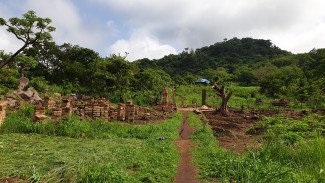|
|
|
Many small island developing states (SIDS) and least developed countries (LDCs) are perpetually vulnerable to natural disasters and climate change.
The Bahamas is still counting the costs of Hurricane Dorian, while just over a year ago Hurricanes Irma and Maria wrought devastation across the Caribbean. Earlier this year, Mozambique’s improving economic prospects were dealt a harsh blow by Tropical Cyclones Idai and Kenneth in March and April, respectively, with the subsequent flooding and landslides affecting neighbouring Malawi and Zimbabwe too. At the other extreme, several Southern African nations are in the grips of one of the worst droughts on record.
Natural disasters are defined as events of natural causes that lead to damage, dislocation or loss of life. These events can be weather-related (flood, drought, storm), geophysical (earthquake, volcano) or biological (epidemic). Since 2015, there have been just over 1,700 instances of natural disasters worldwide, affecting nearly 890 million people and resulting in losses of just under US$720 billion. LDCs accounted for 20% of these natural disasters.
Such disasters are predicted to grow in frequency and severity as a result of climate change, population growth and urbanisation. The economic destruction, human tragedy and loss of life in the wake of these disasters are truly catastrophic, especially for the world’s poorest nations.
Natural disasters exacerbate development challenges
Natural disasters have immediate adverse effects on the economy and can exacerbate the trade and development challenges of LDCs. For these countries, the cumulative effects of preceding shocks compound existing challenges, exacerbate underlying structural trends and could even chill their development prospects.
Frequent devastation caused by natural disasters disrupts countries’ long-term investments and diverts resources away from development to reconstruction. In 2015, Tropical Cyclone Pam caused such devastation in the Pacific that Vanuatu’s graduation from LDC status was delayed to December 2020.
The nexus between trade and natural disasters, and how the multilateral trading system can better support disaster response, recovery and resilience, is now gaining greater attention.
For example, at the 11th World Trade Organization (WTO) Ministerial Conference in December 2017, eastern Caribbean countries had formally proposed “full flexibility” of the multilateral trading system to support reconstruction and recovery from disaster damage. The WTO now spearheads dialogue and research on the nexus between trade and natural disasters, in addition to assessing the trade implications of disasters in some members’ Trade Policy Reviews.
The trading system can better support disaster response and resilience
How can trade assist LDCs hit by natural disasters?
First, LDCs already enjoy considerable flexibility under WTO agreements and access to various international support measures, such as the WTO’s Enhanced Integrated Framework. Aid for trade should be used to build robust trade-related infrastructure and enhance productive capacity, including export diversification, which contribute to greater resilience and economic recovery in the wake of disasters.
Increasing a country’s disaster resilience has benefits for a country’s capacity to trade. However, by 2024, no fewer than 12 LDCs are expected to graduate out of this category, including countries highly vulnerable to natural disasters and climate change effects: Bangladesh, the Solomon Islands and Vanuatu. When LDCs graduate, they lose access to specific support measures, from trade preferences and concessional loans to adaptation support such as the Global Environment Facility Least Developed Countries Fund (LDCF), so transitional support for these countries is critical.
Second, WTO agreements should be carefully examined to determine how existing provisions could be used and improved to support disaster response, recovery and resilience; and what additional flexibilities and special and differential treatment – from market access to subsidies – could be provided to assist disaster-hit countries.
For example, the WTO’s Trade Facilitation Agreement (TFA) already contains measures related to advance rulings, release and clearance of goods, border agency cooperation and freedom of transit. The speedy implementation of such customs and border clearance measures is imperative when natural disasters strike, especially to allow the entry of relief goods and essential supplies.
Many of these imported products will have a strong regulatory component (food, medicines), so the WTO’s sanitary and phytosanitary and technical barriers regimes have to be factored in and balanced with the facilitating aspects of these TFA measures to ensure a timely and efficient response to disasters.
It may also be helpful to provide clarity on what constitutes a relief item, and whether it is exempt from import tax. Revising import tariffs on reconstruction materials may be important to stimulate economic growth and ensure tariffs on construction materials, such as steel and cement, do not disincentivise efforts to “build back better.”
Third, development partners could consider further instruments—trade preferences, adaptation support, disaster risk finance—to assist with response, recovery and resilience efforts.
For example, Article IX:3 of the Marrakesh Agreement Establishing the WTO permits waivers, which have been used to support reconstruction efforts in disaster-hit countries. The WTO’s General Council previously approved waivers for trade preferences to Nepal in the wake of the April 2015 earthquake and to Pakistan after the 2010 floods. Development partners can also support national climate-resilient measures to help economies rebound from the impact of natural disasters.
A holistic approach to trade and disaster management
Finally, given the growing incidence of such catastrophes, further work and support are needed to promote a virtuous cycle between trade policies, social protection policies, resilience-building and disaster risk management, drawing on the Sendai Framework for Disaster Risk Reduction, especially in LDCs.
-------
Brendan Vickers is Adviser and Head of Section and Hilary Enos-Edu is Assistant Research Officer in the International Trade Policy Section, Commonwealth Secretariat, London. Any views expressed are those of the authors and do not necessarily represent those of the Commonwealth Secretariat.
If you would like to reuse any material published here, please let us know by sending an email to EIF Communications: eifcommunications@wto.org.



